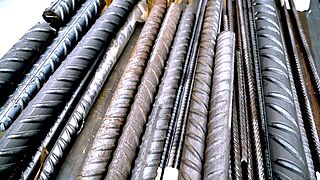Innovative Testing System for Concrete-Reinforcing Steel
Reinforcing steel and ribbed reinforcement bars (rebars) are so vital to civil engineering they form a group of important structural materials, which in the case of concrete-reinforcing steel, are subject to regulatory control. ZwickRoell offers testing solutions to perform tensile tests up to 5,000 kN on concrete-reinforcing steel.
Because concrete has high compressive strength but lower tensile strength, it is reinforced by embedding steel in it. Reinforcing steels are mainly produced in diameters from approx. 10 mm to approx. 50 mm. The smaller diameters are then further processed into mats or lattices before having concrete poured over them on site.
Testing these ribbed concrete-reinforcing steels poses a particular challenge because, apart from cutting to length, no further mechanical specimen preparation takes place. ZwickRoell has developed a tensile tester with a non-contact extensometer for performing tensile tests on concrete-reinforcing steel (DIN 488-2, ISO 15630, ISO 6892-1). The testing machine is equipped with hydraulic grips that ensure secure gripping of various specimens. A unique advantage here is that the specimens with diameters of 10 to 50 mm can be held with only a single pair of grip inserts, eliminating the need to change jaws for different specimen diameters. This not only increases specimen throughput, but also saves investment costs.
The core of the tensile testing machine is the videoXtens extensometer with six integrated cameras. The system measures the strain up to break without making contact using a high-resolution camera. Thanks to automatic rib detection, there is no need for separate specimen marking. Six cameras cover a measurement range of 680 mm with the initial gauge length L0 at 50 to 500 mm. The videoXtens is classified in accuracy class 1 (to ISO 9513) and has a resolution of 0.6 µm. Since the strain can be measured after specimen break using the videoXtens, an automatic determination of the strain at break (A) is provided, eliminating the need to mark and manually measure the specimen after the test.
The optional Test Re-Run module in the testing software testXpert enables retrospective recalculation of strain on the basis of an image series recorded during a test, using a different initial gage-length (provided multiple markings are present). This can be particularly advantageous if, for example, the specimen breaks outside of the initially set measurement range. By using the Strain distribution function, this can even be done live during test straining, meaning the initial gauge length will be moved automatically to the area with the highest strain. This ensures that specimen break always occurs withing the gauge length. Thanks to this function, the number of failed attempts can be greatly reduced, saving not only time but also money (specimen material).
